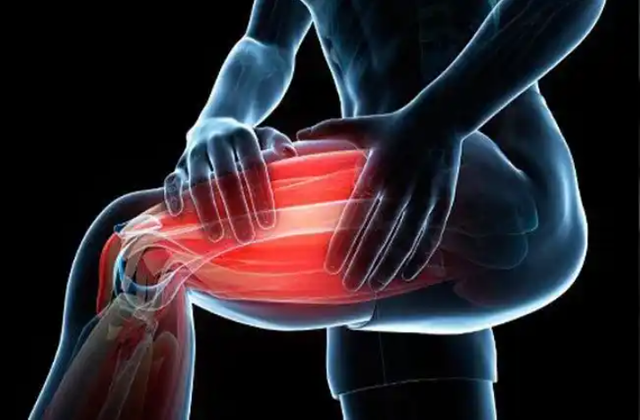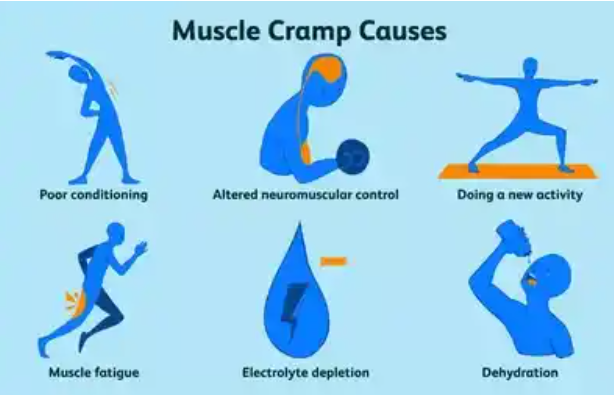WHAT ARE MUSCLE CRAMPS?

Muscle cramps are sudden contractions in one or more muscles. These contractions are involuntary, meaning that a person cannot control them.
These cramps can cause uncomfortable symptoms, but, for the most part, they are temporary. The duration of symptoms typically ranges from seconds to minutes.
WHAT DO CRAMPS FEEL LIKE?
When muscle cramps occur, the person may feel a sudden tightening in the muscle or muscles in the area. It may feel as though they have flexed their muscle, even if they are otherwise relaxed. This tightening often does not stop and leads to pain in the area as the muscle over-contracts.
UNDERLYING ISSUES
In some cases, a muscle cramp may be a sign of an underlying issue in the body, such as:
- Lack of electrolytes or minerals in the body
- Compressed nerves
- Low blood supply
- Conditions in the thyroid
- Cirrhosis
- Diabetes
- Fibromyalgia
- Kidney failure
- Issues during pregnancy
- Amyotrophic lateral sclerosis (ALS)
The muscle may also seem to twitch or spasm.
In some cases, such as with muscles close to the skin, the person may be able to see the contraction in the muscle. A hard knot or lump of tissue may form in the affected muscle.
Many cases of muscle cramps are temporary, with the symptoms appearing and then going relatively quickly. However, in some cases, a person may need to see a doctor for treatment.
Summary
A muscle cramp is a painful tightness in a muscle due to a sudden, involuntary contraction. Various factors may contribute to muscle cramping, but the underlying cause is often unclear.
Muscle cramps may occur almost anywhere in the body, but some common areas include the legs and feet. People with digestive issues or menstrual cramps may experience muscle cramps in the abdomen.
Muscle cramps are mostly temporary and go away on their own. Some home remedies may help longer lasting cramps pass or ease the symptoms.
However, anyone experiencing persistent cramping should speak with their doctor to get a diagnosis. In some cases, treatment may be necessary.
This article discusses muscle cramps in more detail, including their causes, treatment, and prevention. It also explains when to see a doctor about this issue.
What are muscle cramps?
Muscle cramps are sudden contractions in one or more muscles. These contractions are involuntary, meaning that a person cannot control them.
These cramps can cause uncomfortable symptoms, but, for the most part, they are temporary. The duration of symptoms typically ranges from seconds to minutes.
What do cramps feel like?
When muscle cramps occur, the person may feel a sudden tightening in the muscle or muscles in the area. It may feel as though they have flexed their muscle, even if they are otherwise relaxed. This tightening often does not stop and leads to pain in the area as the muscle overcontracts.
The muscle may also seem to twitch or spasm.
In some cases, such as with muscles close to the skin, the person may be able to see the contraction in the muscle. A hard knot or lump of tissue may form in the affected muscle.
CAUSES

Much of the time, it is difficult to identify the exact cause of a muscle cramp. As one articleTrusted Source notes, this is because what appears to be a simple cramp often involves the whole bodily system, affecting the person’s emotional and physical state.
Although there are many possible causes of a cramp, in many cases, the underlying cause is unknown. Some muscles may simply start cramping for a short time and then go back to normal.
Cramps may occur anywhere in the body, but they most commonly affect the legs — specifically, the calves. One article notes that about 80%Trusted Source of cramps occur in the calf muscles.
The reason for this may be that people use the calves throughout the day. However, the exact cause may vary in each case.
The authors of an article in Sports MedicineTrusted Source also note that cramps are hard to study because they are largely unpredictable.
POTENTIAL CAUSES OF TEMPORARY CRAMPING
Temporary muscle cramps could have various causes. Issues that may lead to cramping include:
- Overusing a muscle
- Holding a certain position for a long period
- Minor dehydration
- Using a muscle without stretching it first
- Muscle loss from aging
- General muscle loss from aging, called sarcopenia, may play a role as well.
The American Academy of Orthopaedic Surgeons note that older people are more susceptible to muscle cramps due to normal muscle loss that begins around a person’s mid-40s.
Aging muscles do not work as hard or as quickly, and they may be more susceptible to overuse that could cause cramping.
OTHER UNDERLYING ISSUES
In some cases, a muscle cramp may be a sign of an underlying issue in the body, such as:
- lack of electrolytes or minerals in the body
- compressed nerves
low blood supply - conditions in the thyroid
- cirrhosis
- diabetes
- fibromyalgia
- kidney failure
- issues during pregnancy
- amyotrophic lateral sclerosis (ALS)
NIGHT CRAMPS
Muscle cramps may occur at night as people sleep, typically in the legs. Research notes that about 37%Trusted Source of people over the age of 60 years in the United States experience nocturnal leg cramps.
Muscle cramps at night may be due to a person keeping the muscles in one position for a long period while sleeping, holding an awkward position in bed, or overusing the muscles throughout the day.
However, as with other types of cramps, cramps at night often do not have an identifiable cause.
PERIOD CRAMPS
People who menstruate often get period cramps before and during menstruation each month. The Office on Women’s HealthTrusted Source note that pain is the most common symptom that people experience before or during a period.
The feeling may vary from heaviness in the abdomen to severe cramping in the abdomen and pelvic area.
Pain from period cramps occurs as the uterus contracts. In a period, the uterus contracts to help shed the uterine lining, which the body then expels through the vagina.
TREATMENT
Many cramps are temporary and will simply come and go. Some home treatments may ease the symptoms or help the cramp pass.
Gently stretching the muscles in the area may help relieve the symptoms in some people. Applying pressure and performing deep tissue massage in the area may also lessen the symptoms.
Warm compresses may help by causing the muscles to relax a bit, reducing discomfort or pain. Some people may find that a warm shower or bath eases the cramp.
Over-the-counter (OTC) pain relief medications, such as acetaminophen (Tylenol) or ibuprofen (Advil), may help if the symptoms make it difficult to sleep or focus on other tasks.
Those with period cramps may also find that home remedies help. These may include placing warm water bottles or other warm compresses on the area and taking OTC pain relief medication or anti-inflammatory drugs to ease the symptoms.
PREVENTION
A person may be able to reduce the chance of muscle cramps by avoiding some of their common causes. Some general prevention tips include:
- Staying hydrated by drinking plenty of water
- Replenishing electrolytes in the body, especially after working out
- Reducing alcohol intake
- Stretching before using the muscles
- Avoiding overexertion, especially when it involves the muscles that tend to cramp up
Even with these tips, some cramps may still occur. It is not always possible to avoid all cases of cramping.
Anyone taking medications that cause dehydration or muscle cramps may wish to speak with their doctor to discuss alternatives.
People experiencing severe pain from muscle cramps should see their doctor, especially if the pain does not go away. Those who experience other signs and symptoms alongside muscle cramps should also seek medical advice. These signs and symptoms may include:
muscle weakness in the cramping muscles
swelling in the area
numbness
skin changes, such as discoloration or rashes
cramps that happen frequently or become more common
Additionally, cramps that do not respond to home treatments may be a sign to see a doctor.
A doctor can diagnose any underlying issues and suggest ways to relieve the symptoms.